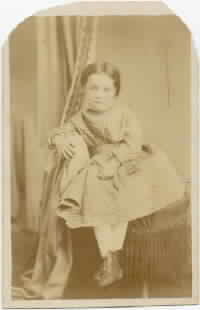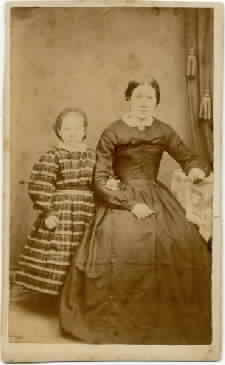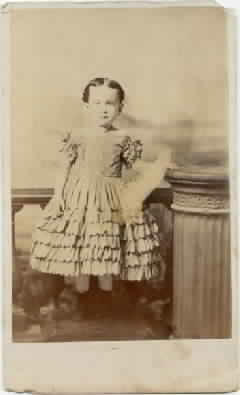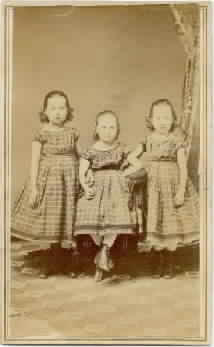For mothers who
want their daughters to have the "look" of the period there are certain
characteristics which define that "look". It is easily achieved and
will transform your daughter into a child of the l860's. Since we seek
to "RE-create" history and not to create it as we go recreating dresses
using the cut, fabric, and texture of the past is critical.
"Advanced
Children's Guidelines" were drafted by Vickie Rumble to illustrate what
children of the 1860's actually wore. The CDVs below are from Mrs.
Rumble's collection and are typical of what little girls wore once they
were past the toddler age. You will note the little girls shown here
have their hair parted in the center just like their older sisters and
mothers. While they aren't old enough yet to wear their hair swept into
a bun they have had this center part since birth.
The fabrics are
the same as might have been used for their mothers, in fact might have
been made from the remnants of Mother's dress. Natural fibers are a
must in recreating these precious dresses - cotton, wool, or silk
depending on the persona.
Fabrics for
little girls' dresses might have been calico as in the case of the
little darling sitting on the photographer's stool. It might also have
been a plaid - of varying size as in the case of the little girl shown
with her mother, or the three sisters. Stripes would be appropriate.
In choosing calico be very careful of pattern and color combinations -
your Mentor will be happy to refer you to textile books and CDVs for
calicos suitable to the era.
Before we break
the images down one by one let's discuss the general characteristics
found in these garments.
Bodices button
up the back. Bodices are gathered onto a
waistband. Skirts often have growth tucks
between thigh and ankle length. Necklines are
either boat or jewel. Sleeves may be long or
short and gather into a band. Bodices and
skirts should match creating a one-piece garment.
CDVs do not indicate use of lace on children's
dresses. Even the dressy dress below does not use lace. Period lace is
very difficult to duplicate with what is available today so we recommend
not using it.
Shoes had square
toes, laces, and thin heels . Stockings most often seem to be white.
For infants:
very simple dresses that are very long. Fabric is gathered into a
neckband. Simple bonnets or knitted ones for warmth in winter. Gowns
were sometimes pinned in the back though we do not recommend the use of
straight pins for safety reasons.
We recommend
using established authentic patterns to achieve the proper cut and fit
for these clothes. Please avoid trying to duplicate on your own unless
you are an advanced level seamstress capable of achieving this without
benefit of a pattern. These dresses did not fit like little girls'
dresses of today, therefore, modern patterns will not give you this
"look". Please also avoid trying to down-size
adult dresses for young ladies - styles were too different for these two
ages.
With skirts and
jackets the same applies as for ladies - a white blouse was an
undergarment, and was not worn in public without a jacket or other
treatment over it. White blouses were featured in late war Godey's,
however, when we consider that very few Southern civilians were
receiving Godey's by that time it is unlikely they were being worn by
Southern girls, especially for an early to mid war event. A dress as
described above is far more appropriate. If you want the jacket or need
it for warmth please consider adding a jacket to a dress as described
above (matching skirt and bodice).
Karen Crocker's
line of "For the Little Ones" patterns, and a line being developed by
Elizabeth Stewart Clark are highly recommended.

This young lady
is wearing a dress of calico with a gathered bodice and jewel neckline.
Sleeves are long with the appearance of a simple ruffle at the cuff.
Her bodice is gathered onto a waistband. There is no evidence of
growth tucks. Her ensemble is completed with the use of white
stockings, and square toe lace-up boots. Very much the "look".

This young lady,
older by perhaps 2 or 3 years than the little girl in the first image,
is wearing a dress of plaid with a white collar like her mother's, long
sleeves gathered into a band, and again the bodice is gathered onto a
waist band. Her dress is longer as dictated by her age. There seems to
be one growth tuck just above the third white line in the fabric. We
cannot see her shoes and stockings but they would mirror the ones in the
first image. This smart young lady's hair is pulled back from her face.

This young lass
is dressed in the height of fashion - ready for a party or fanciful
occasion. Her bodice has the appearance of being pleated, and the short
puffed sleeves have scalloped ruffles to match the skirt. The bodice is
attached to a band and the skirt has multiple rows of scalloped ruffles.
This finish was not hemmed and worked much like cutting fabric with
pinking shears, except the scallops are larger. Her bodice has a boat
neck and she is wearing a necklace of some sort. Accessories of white
stockings and square toe boots are visible. A faint pattern can be
detected in the fabric which could be silk in keeping with the
extravagance of this dress.

These adorable
sisters, perhaps triplets, are wearing identical dresses of plaid.
Bodices are gathered onto a band and there is a boat neckline with
puffed short sleeves. There are no discernible growth tucks but the
trim near the hem might have been applied later to cover the area where
a tuck had already been let out. Their hair is worn pulled back from
the face, each has a matching necklace, and the outfit is worn with
white stockings and square toe boots.
Each
of these images shows little girls in different dresses, but each has
"the look" of the period. They were the apples of their mothers' eye
when these images were struck, and your little miss can achieve the same
"look" today.




